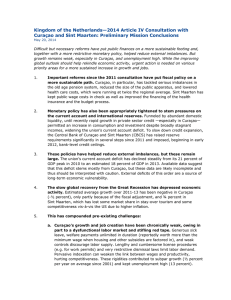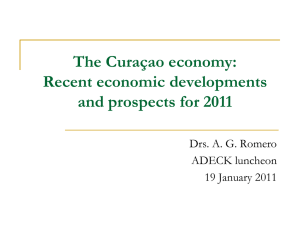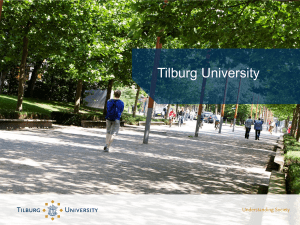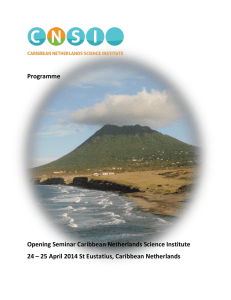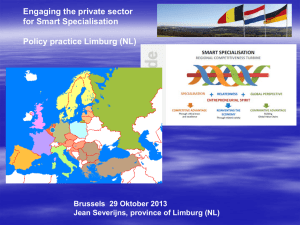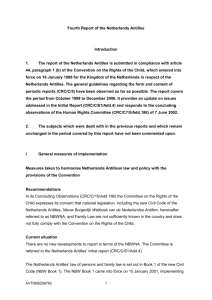Constitutional and Political Changes in the Dutch
advertisement
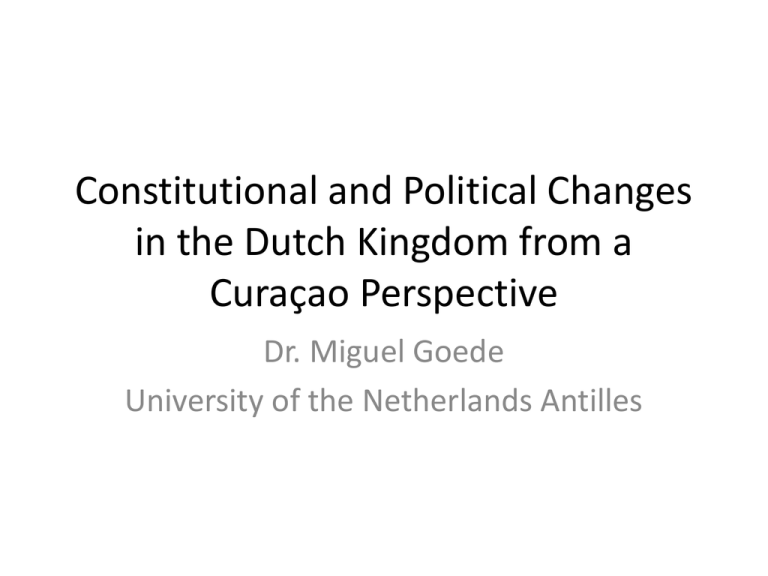
Constitutional and Political Changes in the Dutch Kingdom from a Curaçao Perspective Dr. Miguel Goede University of the Netherlands Antilles Perspecive • • • • • Timeline Political Constitutional Social and psychological Personal 101110 Tomas 101010 • The Netherlands Antilles stoped to exist • Curaçao and St. Maarten become countries and partners in the Dutch Kingdom • Bonaire, Saba and St. Eustatius become Dutch municipalities/ Public bodies But wasn’t it always about becoming independent? • The Antillian Parlement has exisited for 72 year when it was absolved on 9 October 2010 – First 6 islands – Aruba left in 1986 and obtained an autonoums status • 5 April 1938 first meeting after elections of 20 December 1937 – 5 appointed members – 5 elected members – 6 Curaçao, 3 Aruba, 1 Bonaire, 1 Windward Islands • Elections in 1936 based on the 1936 constitution • Political parties emerge 22 march 1942 London Speech • 1954 New Order • It stated from the start that the Statuut was not forever • The Netherlands Antiles were removed from UN decolonization list • 742 (VIII). Factors which should be taken into account in deciding whether a Territory is or is not a Territory whose people have not yet attained a full measure of self-government. • Changese in 1948 • Aruba 8, Curaçao 8, Bonaire 2, Sint Maarten, Saba and Sint Eustatius each 1. • Universal sufrage • Changes in 1955 • Aruba 8, Curaçao 12, Bonaire 1 and each Windward Island 1 • 1975 Independance op Surinam – We will send you your independance by mail 6-1=0 • The right of self-detemination per island was created • 1 January 1986 Aruba was granted autonomy • Independance 1996 • Consequences for the Staten • Curaçao 14 zetels, Bonaire 3, Sint Maarten 3, Saba and Sint Eustatius each 1 The 1990’s • 1993 Referendum Curaçao status referendum, 1993 Option Votes Percentage Option A: Restructuring the Netherlands Antilles 48,587 73.56% Option B: Becoming a self governing country within the Kingdom of the Netherlands 11,841 17.93% Option C: Becoming a direct part of the Netherlands 5,299 8.02% 325 0.49% Option D: Independence The new millennium • 2000 – St. Maarten is stepping out • 2005 – Curaçao is the last to hold a second referendum – Autonomous status equal to Aruba – Option independence grows a bit • Results of the negotiations • Slotverklaring 9 Septembers 2010 • Debt relief of 80% of the national debt till 2005 (More than 5 billion Antillean Guilders) • Financial Supervision • More control on Justice • Good Govenance • 2009 – Third referendum • Elections 27 August 2010 – Political shift – 11 – 10 Dutch government • 14 October 2010 – Right – PVV • What is their position on the islands? – 7/1/2008 - helft Nederlanders wil af van de antillen. • Posted in Wij- en zij.. cultuurverschillen onder de loep • Helft Nederlanders wil af van Antillen Gepubliceerd op maandag 07 januari 2008 Nederlanders zijn zeer kritisch over de band tussen ons land en de Nederlandse Antillen. Bijna de helft (49 procent) wil de band met de overzeese gebiedsdelen helemaal doorsnijden. Een ruime meerderheid (60 procent) wil dat als de Antillen per se bij Nederland willen blijven horen, ons land de eis stelt dat de eilanden onder direct Nederlands bestuur komen te staan. Dat blijkt uit een onderzoek dat in opdracht van DAG werd uitgevoerd door Maurice de Hond. 30 years of debate • 101010 • 111010 • 111110 Constitutional and Political Changes in the Dutch Kingdom from a Curacao Perspective (II) Dr. Miguel Goede University of the Netherlands Antilles Introduction • 101010 • Curaçao and St. Maarten • Bonaire, St. Eustatius, Saba • On the basis of an outline agreement concluded in September 2005 – Division of society • The Round Table Conference in Curaçao on 15 December 2008 • The conclusions of the final Round Table Conference were signed on 9 September 2010. These stated that the amended Charter for the Kingdom of the Netherlands would enter into force as planned on 10 October 2010. As of 10-10-‘10 the Netherlands Antilles has ceased to exist. • The three other islands, Bonaire, Sint Eustatius and Saba have voted for direct ties with the Netherlands and are now part of the Netherlands, thus constituting ‘the Caribbean part of the Netherlands’. Responsibility for foreign relations • As of 10 October 2010, the Caribbean countries of the Kingdom of the Netherlands (Aruba, Curaçao and Sint Maarten) each have their own Foreign Relations Department. What does the constitutional reform mean for the Kingdom? • On 10 October 2010 the Netherlands Antilles ceased to exist as a country within the Kingdom of the Netherlands. The Caribbean part of the Kingdom of the Netherlands is now made up of the countries of Aruba, Curaçao and Sint Maarten (each with its own government) and, as public bodies of the Netherlands, the islands of Bonaire, Sint Eustatius and Saba. As in Aruba, the government of the Kingdom is represented in the new countries of Curaçao and Sint Maarten by a Governor. Will there be changes to the way in which the Kingdom promotes its interests abroad? • No, the Kingdom will continue to promote its interests abroad in the same way. • The Kingdom’s external borders have not changed. • Foreign relations and defence remain ‘Kingdom affairs’. How are governance and legislation organised following the constitutional reform? • Like Aruba, the new countries, Curaçao and Sint Maarten, each have their own government and parliament. Together, these institutions are empowered to enact legislation in regard to the countries’ own affairs. The Dutch public bodies of Bonaire, Sint Eustatius and Saba have the power to regulate their own internal affairs. Each public body has a local executive and a local council. What is the Netherlands’ role in relation to the other countries of the Kingdom following the constitutional reform? • The Netherlands works together with the Caribbean countries in the Kingdom in the interests of protecting the independence of the judiciary, tackling corruption and cross-border crime, and maintaining public order. A joint Court of Justice is responsible for the administration of justice in the Caribbean part of the Kingdom, and a single Procurator General is in charge of the Public Prosecution Service for Curaçao, Sint Maarten, and Bonaire, Sint Eustatius and Saba. Aruba has its own Procurator General. The three police forces serving Curaçao, Sint Maarten and Bonaire, Sint Eustatius and Saba respectively also work together closely. How does the Netherlands manage its governance tasks on Bonaire, Sint Eustatius and Saba now that they have public body status? • Bonaire, Sint Eustatius and Saba now maintain two tiers of government, i.e. a local authority and the Dutch central government. Broadly speaking, central government has taken over the duties performed previously by the Antillean authorities. The local government is under the control of the local representative assembly (‘the island council'). As well as taking over the tasks of the Netherlands Antillean authorities, the Dutch government has also taken on certain tasks previously the responsibility of the islands, such as management of the fire service. • The implementation of the Netherlands' tasks on Bonaire, Sint Eustatius and Saba (and the related support services) is the responsibility of the Department for the Netherlands in the Caribbean (Rijksdienst Caribisch Nederland), which has a branch on each of the islands. How is financial supervision organised following the constitutional reforms? • A Financial Supervision Authority has been established for Curaçao and Sint Maarten to supervise public finances under the ultimate responsibility of the Council of Ministers for the Kingdom. A similar body has been set up for Bonaire, Sint Eustatius and Saba under the minister responsible for Kingdom Relations. This type of oversight structure will continue to exist in the new constitutional situation. The underlying supervisory principles are a balanced budget, prudent financial management and a cap on contracting debt. Has there been any change to the Joint Court of Justice of the Netherlands Antilles and Aruba as a result of the constitutional reforms? • Yes, the existing Joint Court of Justice of the Netherlands Antilles and Aruba has become the Joint Court of Justice of Aruba, Curaçao, Sint Maarten and the Caribbean part of the Netherlands (i.e. Bonaire, Sint Eustatius and Saba). The Supreme Court remains the court of cassation for the Caribbean parts of the Kingdom. How does the Kingdom ensure that public order, safety and security are maintained in the new constitutional situation? • Responsibility for maintaining public order, safety and security and running the emergency services on Curaçao and Sint Maarten now fall to the respective Ministers of Justice of the new countries. On Bonaire, Sint Eustatius and Saba the local authorities will be responsible for public order, crisis management and disaster response. The Public Safety and Security Act for Bonaire, Sint Eustatius and Saba also provides for special powers in the event of incidents whose scale exceeds a single island’s capacity. What is the role of the Public Prosecution Service in the different countries of the Kingdom in the new constitutional situation? • Investigative and prosecutorial powers rest with the Procurator General. There is a single Procurator General for all the Caribbean parts of the Kingdom that once made up the Netherlands Antilles: the new countries of Curaçao and Sint Maarten and the three new public bodies of the Netherlands: Bonaire, Sint Eustatius and Saba. The Procurator General is the head of the public prosecution services in the new countries and the new public bodies. There is a joint Procurator General’s Office, with a staff including two advocates general. In Aruba, the situation has not changed in any respect as a result of these reforms. That country continues to have its own Procurator General. What currency will Curaçao, Sint Maarten and the Netherlands in the Caribbean use? • On 1 January 2011, the US dollar will replace the Antillean guilder on Bonaire, Sint Eustatius and Saba. Curaçao and Sint Maarten have a joint central bank. The Caribbean guilder will be introduced on 1 January 2012 as the countries’ common currency. Until that time, the Antillean guilder will remain the official currency. What is the relationship between the Caribbean parts of the Kingdom and the EU? • The Netherlands is a European Union member state, but Aruba, Curaçao, Sint Maarten, and the Caribbean part of the Netherlands (Bonaire, Sint Eustatius and Saba) are not. Instead they have the status of Overseas Countries and Territories (OCT). As a result, the islands enjoy a number of advantages, for example where the export of goods to the EU is concerned. In addition, the islands receive funding from the European Development Fund (EDF). And since citizens of the Caribbean parts of the Kingdom are Dutch nationals and thus EU citizens, they may also vote in European Parliament elections. The constitutional reform does not affect the islands' relationship with the EU. How is the Representation of the Netherlands in Aruba, Curaçao and Sint Maarten organised? • On 1 January 2011, the Representation of the Netherlands in the Netherlands Antilles and the Representation of the Netherlands in Aruba will be integrated to form the Representation of the Netherlands in Aruba, Curaçao and Sint Maarten. • Curaçao wants all options for its development – Adam Smith – St. Eustatius: The Golden Rock • www.sidsgg.com • www.miguelgoede.com
